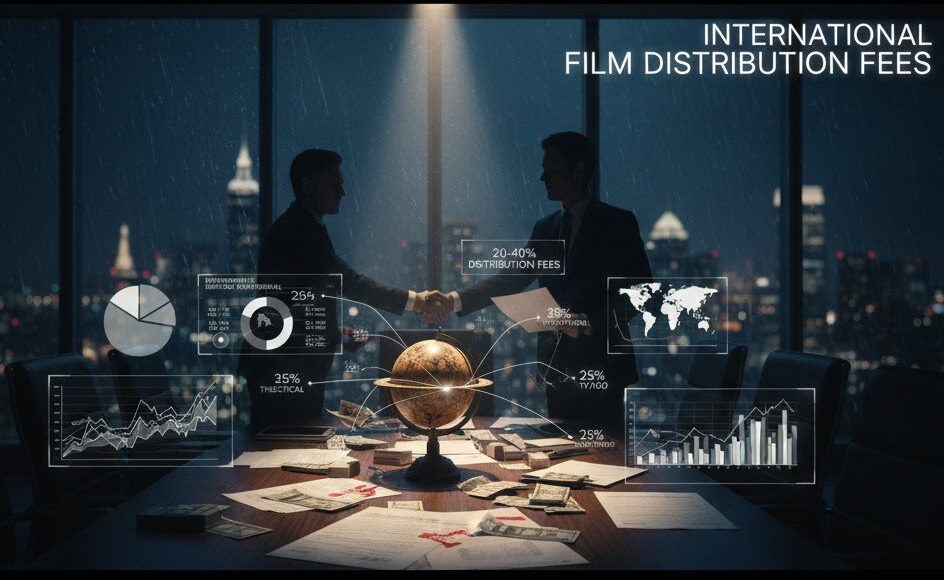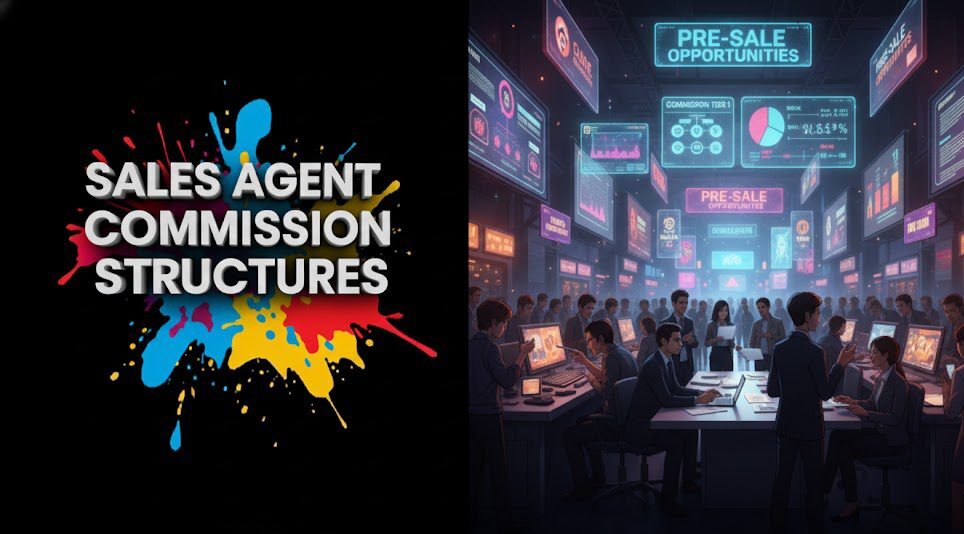Introduction
Welcome, filmmakers, producers, and industry visionaries! You’ve poured your creative energy into making a film, but what happens next? Navigating the complex world of Film sales and distribution is the crucial next step to ensure your masterpiece reaches audiences and achieves its commercial potential. In today’s ever-evolving media landscape, understanding how to strategically sell and distribute your film is more important than ever.
This comprehensive guide will illuminate the path, covering everything from foundational concepts and crafting winning sales strategies to exploring diverse distribution channels, leveraging industry markets, decoding deal terms, and looking at the future of how films connect with viewers globally. Whether you’re an independent filmmaker or a seasoned producer, understanding the ins and outs of Film sales and distribution is key to your success. Let’s embark on this journey together!
Table of content
- Introduction
- Key-Takeaways
- Understanding Film Sales and Distribution: The Basics
- Crafting a Winning Film Sales Strategy
- Navigating Modern Film Distribution Channels
- The Role of Film Markets and Festivals
- Decoding Deals and Agreements in Film
- Spotlight on Independent Film Sales and Distribution
- The Impact of Marketing and Promotion
- Taking Your Film Global: International Sales
- The Influence of Technology and Data (Featuring Vitrina AI)
- Future Trends in Film Sales and Distribution
- Conclusion
- FAQs
Key Takeaways
| Pillar Aspect | Core Insight |
|---|---|
| Definition & Importance | Film sales and distribution encompasses all processes involved in selling the rights to a film and getting it to various audiences through multiple channels. It’s vital for revenue generation and audience reach. |
| Strategic Sales | A robust sales strategy involves understanding your film’s value, identifying target buyers (distributors, platforms), and effectively pitching your project, often with the help of sales agents. |
| Distribution Channels | Modern distribution spans theatrical releases, streaming platforms (SVOD, AVOD, TVOD), television broadcast, and ancillary markets like educational and inflight entertainment. |
| Markets & Festivals | Key industry events like Cannes, Berlinale (EFM), and AFM are crucial for networking, sales, and launching films into the distribution pipeline. |
| Deals & Agreements | Understanding legal contracts, licensing terms, rights management (territorial, windowing), and negotiation is fundamental to protecting your interests and maximizing returns. |
| Global Reach & Technology | International sales and leveraging technology and data, like insights from Vitrina, are increasingly critical for maximizing a film’s global footprint and revenue potential. |
Navigating the Complexities of Global Film Distribution?

Understanding Film Sales and Distribution: The Basics

At its core, Film sales and distribution is the entire process of getting a completed film from the filmmakers to the audience. “Sales” primarily refers to selling the exhibition rights of a film to entities that will make it available to viewers. “Distribution” is the mechanism by which this happens. Without effective sales and distribution, even the greatest film remains unseen, and its commercial potential untapped. It’s the bridge between creation and consumption. For anyone serious about a career in filmmaking, grasping these fundamentals is non-negotiable. This understanding forms the bedrock of your entire approach to bringing your cinematic vision to the world and is essential for navigating the complexities of the movie sales process.
What is film sales and distribution at its core?
Film sales involves the licensing of rights to a film. This isn’t usually selling the copyright outright, but rather granting specific permissions – for example, the right for a company to show the film in cinemas in a particular country for a set period, or for a streaming service to offer it to their subscribers. Key players in film sales include film sales agents, who represent films and negotiate deals with buyers. Film distribution is the practical side: the logistics of delivering the film to various exhibition platforms (theaters, streaming services, TV networks) and ensuring it reaches the intended audience. This involves everything from creating distribution prints/digital files to marketing and promotion in specific territories. The two are intrinsically linked; sales secure the deals, and distribution executes them. Understanding how film distribution works involves recognizing this synergy.
Why is a strategic approach to film sales and distribution crucial for filmmakers?
A strategic approach to Film sales and distribution is paramount because:
- Maximizes Revenue: A well-thought-out strategy helps you secure the best possible deals across multiple territories and platforms, maximizing your film’s earning potential. This includes considering options like pre-sales to help finance the film.
- Reaches Target Audiences: Strategy ensures your film gets in front of the people most likely to appreciate it, whether that’s through a targeted festival run, a specific streaming platform, or a niche theatrical release.
- Builds Filmmaker Profile: Successful distribution builds your reputation and track record, making it easier to fund and sell future projects.
- Navigates a Complex Market: The film market is crowded and constantly changing. A strategy helps you cut through the noise and find the right partners.
- Optimizes Resource Allocation: It helps you decide where to focus your limited marketing and outreach efforts for the best return.
Without a strategy, you might secure a poor deal, miss key markets, or see your film languish unseen. This is particularly true for independent film distribution explained simply: strategy is survival.
| Component | Description | Key Consideration |
|---|---|---|
| Film Sales | Licensing exhibition rights to buyers. | Territories, platforms, exclusivity, term length. |
| Film Distribution | Delivering the film to audiences via various channels. | Logistics, marketing, release windows. |
| Sales Agents | Intermediaries who broker deals for films. | Track record, market connections, commission rates. |
| Distribution Strategy | A plan for selling and distributing a film. | Audience targeting, revenue goals, market positioning. |
(For a deeper dive, explore our upcoming article: “Understanding Film Sales and Distribution: A Beginner’s Guide to Getting Your Movie Seen”)
Crafting a Winning Film Sales Strategy
A successful journey in Film sales and distribution begins with a robust sales strategy. This isn’t just about finding *a* buyer; it’s about finding the *right* buyers and structuring deals that align with your film’s potential and your overall goals. Your film sales strategy is your roadmap to attracting distributors and maximizing revenue, whether you’re aiming for international markets or focusing on specific regions. It involves careful planning, understanding your film’s unique selling propositions, and knowing how to navigate the marketplace effectively. This often means deciding between working with a film sales agent vs direct sales, and considering tactics like generating pre-sales for your film.
Key elements of an effective film sales plan.
An effective movie sales plan should include:
- Film Valuation: Honestly assess your film’s strengths, weaknesses, target audience, and comparable film performance to understand its market value.
- Target Buyer Identification: Research and identify distributors and platforms whose acquisition history and audience profile align with your film.
- Sales Materials: Prepare a professional press kit, a compelling trailer, a poster, a detailed synopsis, and potentially a lookbook.
- Festival and Market Strategy: Determine which film festivals and markets are most relevant for launching your film and connecting with buyers.
- Rights Management Plan: Decide which rights you are willing to sell (territorial, platform-specific, exclusivity, term) and have a clear idea of your ideal deal structure.
- Negotiation Points: Understand key deal terms like minimum guarantees (MGs), revenue sharing, and expense caps.
This plan should be adaptable, as market conditions and opportunities can change. Having a clear film market strategy from the outset is crucial.
The role of film sales agents and how to choose one.
A film sales agent can be a crucial partner in your Film sales and distribution efforts. They specialize in selling films to distributors across various territories and platforms. Their role typically involves:
- Developing the sales strategy for the film.
- Creating marketing materials tailored to buyers.
- Pitching the film to their network of distributors at markets and throughout the year.
- Negotiating deal terms on behalf of the filmmaker.
- Managing the collection of revenues (in some cases).
When choosing a sales agent, consider their track record with similar films, their relationships in key territories, their transparency, their proposed strategy for your film, and the terms of their agreement (commission, expenses). It’s vital to find an agent who is passionate about your film and has a realistic plan for attracting film buyers.
| Strategic Element | Purpose | Example |
|---|---|---|
| Film Valuation | Determine realistic sales expectations. | Comparing box office/streaming performance of similar indie dramas. |
| Target Buyer List | Focus sales efforts efficiently. | Identifying distributors known for acquiring horror films. |
| Sales Materials | Create a professional impression and generate interest. | A dynamic trailer and a well-designed poster. |
| Festival Strategy | Launch the film and create buzz among buyers. | Premiering at a genre-specific festival like Sitges. |
(Explore more in our future piece: “Crafting a Winning Film Sales Strategy: Key Elements for Attracting Buyers & Maximizing Revenue”)
The Role of Film Markets and Festivals
Film markets and festivals are the lifeblood of the Film sales and distribution ecosystem. They are critical meeting points where filmmakers, producers, sales agents, distributors, and financiers converge. Attending and strategically utilizing these events can significantly boost your film’s visibility, help you secure sales, and build invaluable industry connections. Whether you aim to sell your film at a festival or navigate the bustling halls of a market like the Cannes Film Market (Marché du Film), Berlinale European Film Market (EFM), or the American Film Market (AFM), preparation is key.
How major film markets (Cannes, EFM, AFM) drive sales and distribution.
Major film markets are intense, business-focused events where a significant portion of the year’s Film sales and distribution deals are initiated or closed. Their functions include:
- Screenings for Buyers: Sales agents and producers screen their films (or promos for films in production) for accredited distributors.
- Sales Booths: Sales companies set up booths to meet with distributors, discuss their slates, and negotiate deals.
- Networking: Countless opportunities to meet decision-makers from around the world.
- Project Pitching: Many markets have co-production forums or pitching sessions for projects in development.
- Trend Spotting: Gaining insights into what types of films are in demand and what deals are being made.
Success at these markets often depends on having a strong film, a clear strategy, and the ability to effectively network and pitch. Getting a film into Sundance for film distribution discussions, for example, often starts with a strong festival premiere that attracts buyer attention.
Leveraging film festivals for visibility, awards, and sales opportunities.
Film festivals, while also business opportunities, often have a stronger focus on the artistic and cultural aspects of cinema. They can be instrumental for Film sales and distribution by:
- Generating Buzz: A world premiere at a prestigious festival (e.g., Sundance, Toronto (TIFF), Venice, Berlin, Cannes official selection) can create significant media attention and buyer interest.
- Winning Awards: Awards can greatly enhance a film’s marketability and perceived value.
- Securing Reviews: Positive reviews from festival screenings can be powerful sales tools.
- Attracting Sales Agents: Many agents scout festivals for new talent and films to represent.
- Direct Sales Potential: Sometimes, distributors will acquire films directly out of festivals.
Choosing the right festivals for your film (genre-specific, regional, top-tier) is a critical part of your overall Film sales and distribution strategy. Effective networking at film markets and festivals is an art form in itself.
| Event Type | Primary Focus | Key Benefit for Filmmakers |
|---|---|---|
| Major Film Markets (Cannes, EFM, AFM) | Deal-making, sales, international co-production. | Access to global distributors, sales negotiations. |
| Top-Tier Film Festivals (Sundance, TIFF) | Premieres, awards, critical buzz, industry networking. | Launchpad for sales, attracting agents/distributors. |
| Genre Festivals (Sitges, Fantasia) | Showcasing specific types of films (e.g., horror, sci-fi). | Reaching niche buyers and enthusiastic fanbases. |
| Regional/National Festivals | Local talent, cultural focus. | Building local audience, initial industry connections. |
(Look for our future guide: “Leveraging Film Markets & Festivals for Sales and Distribution Success: A Practical Guide”)
Want to Connect Your Film with the Right Audience Worldwide?

Decoding Deals and Agreements in Film
The dotted line: it’s where creativity meets commerce in Film sales and distribution. Understanding the intricacies of a film distribution agreement or a film sales contract is absolutely essential for protecting your rights and ensuring you get a fair deal. These legal documents can be dense and complex, filled with industry-specific jargon. Key elements like movie licensing terms, distribution deal points, the concept of a minimum guarantee in film, and how revenue share in film distribution works are crucial. Whether you’re working with a sales agent or directly with a distributor, legal literacy is your best defense.
Key terms and clauses in film sales and distribution contracts.
Some common terms you’ll encounter:
- Territory: The specific geographic region(s) where the distributor has rights to exhibit the film.
- Term: The length of time the distributor holds these rights (e.g., 5, 7, 10 years).
- Media/Rights Granted: Specifies which platforms the distributor can use (e.g., theatrical, SVOD, TV, VOD, ancillary). Can be exclusive or non-exclusive for certain rights.
- Minimum Guarantee (MG): An upfront payment from the distributor, often recoupable against future revenues. Not all deals include an MG.
- Revenue Share/Royalties: The percentage of net revenues (after agreed-upon expenses) that will be paid to the filmmaker/rights holder.
- Distribution Fee: The percentage the distributor takes from revenues to cover their services.
- Expenses Cap: A limit on the distribution expenses (e.g., marketing, prints) that the distributor can deduct before calculating the filmmaker’s share.
- Deliverables: The list of technical and marketing materials the filmmaker must provide.
A film sales agent agreement will also have its own set of terms regarding commission, term of representation, and covered territories.
Negotiation essentials and protecting your rights.
Negotiation is a critical part of the Film sales and distribution process. Here are some essentials:
- Seek Legal Counsel: Always have an experienced entertainment lawyer review any contract before you sign. This is non-negotiable.
- Understand Your Leverage: The more buzz, festival awards, or demonstrable audience appeal your film has, the more leverage you have in negotiations.
- Prioritize Your Goals: What’s most important to you? A large MG? Better revenue share? Creative control over marketing?
- Don’t Be Afraid to Ask Questions: If you don’t understand a clause, ask for clarification.
- Get Everything in Writing: Verbal agreements are not enough.
- Pay Attention to Definitions: How terms like “Net Receipts” are defined can hugely impact your earnings.
- Consider Audit Rights: The right to audit the distributor’s books to verify revenue reporting.
Properly managing international distribution rights and other complex aspects requires diligence and expert advice.
| Contract Term | What it Means | Negotiation Point Example |
|---|---|---|
| Minimum Guarantee (MG) | Upfront payment to filmmaker, recoupable by distributor. | Negotiating a higher MG based on festival buzz. |
| Revenue Share | Percentage of net profits paid to filmmaker. | Arguing for a more favorable split (e.g., 50/50 vs. 30/70). |
| Expenses Cap | Limit on recoupable distribution expenses. | Ensuring the cap is reasonable and clearly defined. |
| Territory & Term | Geographic scope and duration of rights. | Limiting rights to specific territories or a shorter term if advantageous. |
(Stay tuned for: “Decoding Film Sales and Distribution Agreements: Key Terms, Rights, and Negotiation Essentials”)
Spotlight on Independent Film Sales and Distribution
The world of independent film distribution presents a unique set of challenges and opportunities. Indie filmmakers often operate with tighter budgets and less established industry connections, making the journey to sell an indie film particularly demanding. However, the rise of digital platforms and a growing appetite for diverse voices mean that success is achievable. Strategies like self-distribution for independent films, creatively finding distributors for indie films, and exploring innovative ways of monetizing independent movies are all part of the modern indie toolkit. Even for low-budget film distribution, a smart approach can yield impressive results.
Challenges and opportunities unique to independent filmmakers.
Challenges:
- Limited Budgets: For production, marketing, and festival attendance.
- Discoverability: Standing out in a crowded market without a major studio’s marketing muscle.
- Access to Sales Agents/Distributors: It can be harder to get on the radar of established players.
- Negotiating Power: Often less leverage when dealing with larger companies.
Opportunities:
- Creative Freedom: Indie films can often take more risks and tell unconventional stories.
- Niche Audiences: Ability to connect deeply with specific communities of interest.
- Digital Platforms: More avenues for direct distribution or reaching specialized streamers.
- Agility: Smaller teams can often adapt more quickly to market changes.
- Direct Fan Engagement: Building a loyal fanbase through social media and crowdfunding can be a powerful asset.
DIY film distribution has become a viable, albeit labor-intensive, option for some.
Strategies for finding distribution and monetizing indie films.
Effective strategies include:
- Targeted Festival Strategy: Focus on festivals that champion indie films and attract relevant buyers.
- Building an Online Presence: Use social media, a film website, and email lists to cultivate an audience even before distribution.
- Networking Aggressively (and Smartly): Connect with other filmmakers, programmers, and industry professionals.
- Considering Hybrid Distribution Models: Combining self-distribution for certain rights/territories with traditional deals for others.
- Exploring Aggregators: Services that help get your film onto VOD platforms like iTunes or Amazon, for a fee or revenue share.
- Direct-to-Fan Sales: Selling directly from your website or through platforms like Vimeo On Demand.
- Educational and Community Screenings: A strong path for many documentaries and issue-driven films.
Understanding how to effectively sell your indie film involves creativity not just in filmmaking, but in business too.
| Indie Strategy | Benefit | Example |
|---|---|---|
| Targeted Festival Run | Build buzz, attract niche distributors. | Premiering a horror indie at Fantasia Fest. |
| Crowdfunding Audience Engagement | Validate audience interest, fund marketing. | Using Kickstarter to build a community around the film. |
| Hybrid Distribution | Maximize control and revenue from different rights. | Self-distributing in home territory, sales agent for international. |
| Utilizing Aggregators | Access to major VOD platforms. | Using a service like Filmhub or Quiver Digital. |
(Our upcoming feature: “Independent Film Sales and Distribution: Challenges, Opportunities, and Strategies for Success”)
The Impact of Marketing and Promotion
Creating a brilliant film is one thing; ensuring that both potential buyers and eventual audiences know about it Promotion
Creating a brilliant film is one thing; ensuring that both potential buyers and eventual audiences know about it is another. Effective film marketing for distribution and strategies to promote your film for sales are indispensable components of the Film sales and distribution lifecycle. A well-crafted marketing plan can significantly enhance your film’s appeal to distributors, create anticipation among viewers, and ultimately drive revenue. This involves everything from developing a compelling movie press kit and a killer film trailer strategy to leveraging social media for film distribution and fostering genuine audience engagement for films.
Essential marketing materials for attracting buyers and audiences.
Key marketing assets include:
- EPK (Electronic Press Kit): A digital package containing a synopsis, logline, filmmaker bios, cast and crew list, high-resolution stills, poster artwork, trailer, and positive reviews or laurels.
- Trailer(s): A powerful, concise, and engaging trailer is often the first taste buyers and audiences get of your film. Consider different versions for different purposes (e.g., sales teaser, theatrical trailer).
- Poster/Key Art: The primary visual identity of your film. It needs to be striking and representative of the film’s genre and tone.
- Website & Social Media Presence: A professional website and active, engaging social media profiles for the film.
- Pitch Deck: For sales agents and distributors, a visually appealing deck outlining the film’s concept, cast, comparables, target audience, and sales potential.
High-quality materials signal professionalism and belief in your project, crucial for positioning your film for buyers.
Strategies for creating buzz and engaging potential viewers.
Generating excitement involves:
- Festival Publicity: Leveraging festival selections for press coverage, reviews, and social media buzz.
- Public Relations (PR): Working with publicists to secure media interviews, features, and reviews in relevant outlets.
- Social Media Campaigns: Creating shareable content, running targeted ads, engaging with influencers, and building a community around your film.
- Targeted Advertising: Online ads, and potentially traditional ads, aimed at your film’s specific demographic.
- Grassroots Marketing: Partnering with relevant organizations, hosting special screenings, and engaging directly with fan communities.
- Email Marketing: Building a mailing list to share updates, exclusive content, and release information.
The goal of film publicity is to make your film an event that people don’t want to miss.
| Marketing Element | Purpose | Impact on Sales/Distribution |
|---|---|---|
| EPK (Electronic Press Kit) | Provide essential info to press and buyers. | Facilitates easy access to promotional materials. |
| Trailer | Generate excitement and convey film’s essence. | Key tool for attracting distributor interest and audience attention. |
| Social Media Campaign | Build community, direct engagement, drive awareness. | Can demonstrate audience demand to potential buyers. |
| Festival Publicity | Create buzz, secure reviews, attract industry attention. | Often a catalyst for sales and distribution deals. |
(Learn more in our upcoming article: “Marketing Your Film for Effective Sales and Distribution: Reaching Buyers and Audiences”)
Taking Your Film Global: International Sales
In today’s interconnected world, thinking globally is essential for maximizing a film’s potential. International film sales and achieving global film distribution can unlock significant revenue streams and expose your work to diverse cultures and audiences. However, it also introduces new complexities, such as navigating foreign film distribution landscapes, understanding how to sell film rights by territory, the necessity of localizing films for international markets (dubbing, subtitling), and being sensitive to cultural nuances in film distribution. For ambitious producers, exploring co-production distribution strategies can also be a pathway to international success.
Strategies for selling film rights in different territories.
A common approach is to work with a sales agent who has expertise in multiple territories, or to engage territory-specific distributors. Key strategies include:
- Territorial Licensing: Selling exclusive rights to different distributors for specific countries or regions.
- Windowing Strategy by Territory: Release windows (theatrical, VOD, TV) can vary significantly from one country to another.
- Adapting Marketing Materials: Localizing posters, trailers, and promotional campaigns to suit cultural preferences.
- Attending International Markets: Crucial for meeting buyers from around the world.
- Understanding Local Censorship and Content Regulations: Ensuring your film complies with local standards.
Researching the demand for your film’s genre in specific territories is vital.
The importance of localization and cultural sensitivity.
To succeed internationally, your film needs to resonate with local audiences. This involves:
- High-Quality Dubbing and Subtitling: Essential for non-English speaking markets (and for English-language films in other language markets).
- Cultural Adaptation of Marketing: What works in one culture might not in another. Titles, taglines, and even poster art may need to be adapted.
- Awareness of Local Sensitivities: Understanding cultural norms and avoiding content that might be offensive or misinterpreted.
Effective localization can significantly enhance a film’s appeal and commercial performance in foreign markets, a key aspect of comprehensive Film sales and distribution.
| Global Strategy Element | Purpose | Example |
|---|---|---|
| Territorial Licensing | Maximize revenue by selling to multiple country-specific distributors. | Selling UK rights to one distributor, German rights to another. |
| High-Quality Dubbing | Make content accessible in non-native language markets. | Creating a professional Spanish dub for Latin American release. |
| Localized Marketing Campaign | Ensure promotional materials resonate with local culture. | Designing a new poster with local stars for a South Korean release. |
| Attending International Film Markets | Connect directly with buyers from various regions. | Having a sales agent represent your film at EFM in Berlin. |
(Explore global strategies in: “Taking Your Film Global: Strategies for International Film Sales and Distribution”)
The Influence of Technology and Data (Featuring Vitrina AI)
The landscape of Film sales and distribution is being profoundly reshaped by technology in film distribution and the increasing availability of data. From the rise of streaming platforms for film distribution to the use of AI in film sales and VOD analytics for film, technology offers powerful tools for reaching audiences and making smarter decisions. Forward-thinking professionals are leveraging these advancements to gain a competitive edge. Platforms like Vitrina are at the forefront, providing crucial data and connectivity to enhance how films are sold and distributed worldwide. This is where data-driven film sales become a reality.
How technology is changing film distribution models (e.g., streaming, online marketplaces).
Technology has democratized and fragmented distribution:
- Streaming Dominance: Global and niche streaming platforms have become major buyers and distributors, offering direct access to vast audiences.
- Online Film Marketplaces: Platforms that connect filmmakers directly with distributors or allow for self-distribution and direct-to-consumer sales are emerging.
- Blockchain and NFTs: Experimentation with new models for funding, rights management, and collectibles.
- Advanced Analytics: Platforms provide (or utilize) detailed data on viewing habits, completion rates, and audience demographics, influencing acquisition and content creation.
- Virtual Production & Remote Collaboration: Technologies impacting how films are made also influence post-production workflows and delivery to distributors.
This technological shift demands new skills and adaptability from everyone involved in Film sales and distribution.
The role of data analytics and platforms like Vitrina AI in making informed decisions.
Data is no longer a ‘nice-to-have’; it’s essential. Data analytics can inform:
- Content Valuation: Understanding the potential performance of a film based on comparable titles and audience demand.
- Target Audience Identification: Pinpointing who is most likely to watch a film and where to find them.
- Distribution Strategy: Deciding which platforms and territories offer the best potential ROI.
- Marketing Optimization: Refining campaigns based on real-time performance data.
Vitrina plays a crucial role here by providing comprehensive market intelligence. For professionals in Film sales and distribution, Vitrina offers insights into:
- Global Content Availability: Which films are available on which platforms in which territories.
- Deal Tracking: Understanding who is buying what, and the types of deals being made. (Vitrina’s Project Tracker can show what’s in the pipeline).
- Platform Catalog Analysis: Identifying gaps and opportunities in streamer catalogs.
- Buyer and Seller Discovery: Connecting filmmakers with potential distribution partners worldwide.
By leveraging Vitrina AI for film sales insights, stakeholders can make more strategic, data-backed decisions, reducing risk and increasing the likelihood of success in the complex global marketplace. This is central to a modern approach to Film sales and distribution.
| Technological Impact | Effect on Film Sales/Distribution | Vitrina AI’s Contribution |
|---|---|---|
| Streaming Platform Growth | New major buyers, global reach, complex rights. | Insights into platform catalogs and acquisition strategies. |
| Data Analytics | Informed decision-making, audience targeting. | Provides market data on content demand and deals. |
| Online Marketplaces | Potential for direct sales and new distribution avenues. | Helps identify active buyers and sellers in the digital space. |
| AI in Content Discovery | Enhanced personalization, better content matching. | Tracks trends and content movements, helping predict demand. |
(Delve into this topic with: “The Impact of Technology & Data on Modern Film Sales and Distribution (Featuring Vitrina AI Insights)”)
Future Trends in Film Sales and Distribution
The only constant in Film sales and distribution is change. Staying ahead of future film distribution trends and understanding emerging film sales trends is crucial for all industry professionals. New technologies, evolving viewer preferences, and innovative business models are continually reshaping how films reach audiences. From the rise of virtual film markets and experiments with NFTs in film distribution to the growth of direct-to-consumer film models and the quest for personalized film distribution, the future promises to be dynamic. The impact of AI on film consumption will also be a significant factor to watch.
Emerging models and technologies shaping the future.
Keep an eye on:
- Hyper-Personalization: AI-driven content recommendations becoming even more sophisticated, influencing not just what audiences watch but potentially what gets made and how it’s distributed.
- Interactive and Immersive Content: As technologies like VR/AR mature, new distribution avenues for these experiences will emerge.
- Direct-to-Consumer (DTC) Proliferation: More creators and niche brands may launch their own platforms, bypassing traditional intermediaries.
- Short-Form Video’s Influence: The impact of platforms like TikTok on storytelling and content discovery may influence longer-form content strategies.
- Sustainability in Production & Distribution: Increasing focus on environmentally friendly practices.
- Evolving Theatrical Window: Continued experimentation with the length of time films play exclusively in cinemas before hitting other platforms.
Adaptability will be key to navigating these changes in Film sales and distribution.
Predictions for viewer preferences and platform evolution.
Future viewers are likely to demand:
- More Control and Choice: Over what, when, and how they watch.
- Seamless Cross-Platform Experiences: Easily moving between devices and services.
- Authentic and Diverse Storytelling: A continued appetite for stories from underrepresented voices.
- Community and Shared Experiences: Even in a digital world, the desire for connection around content will persist (e.g., watch parties, social viewing).
Platforms will likely continue to consolidate in some areas while new niche players emerge in others. The ability to provide compelling, differentiated content and a superior user experience will remain paramount.
| Future Trend | Potential Impact on Sales/Distribution | Strategic Consideration |
|---|---|---|
| AI-Driven Personalization | More targeted content delivery, potentially influencing acquisitions. | Understanding how AI algorithms value and surface content. |
| Direct-to-Consumer (DTC) Growth | More competition for established platforms, new opportunities for creators. | Assessing the viability of DTC vs. traditional distribution. |
| Virtual Film Markets | Increased accessibility, potentially lower costs for participation. | Adapting pitching and networking strategies for online environments. |
| Demand for Diverse Content | Greater opportunities for filmmakers from varied backgrounds. | Highlighting unique cultural perspectives in sales pitches. |
(Look forward to: “The Future of Film Sales and Distribution: Emerging Models, New Platforms, and Evolving Viewer Preferences”)
Conclusion
The journey of Film sales and distribution is as vital and often as challenging as the creative process of filmmaking itself. From understanding the foundational principles and crafting a compelling sales strategy to navigating the myriad distribution channels, leveraging industry markets, and decoding complex legal agreements, success demands knowledge, resilience, and adaptability. The modern era, with its technological advancements and shifting viewer habits, presents both unprecedented opportunities and new complexities. By embracing data-driven insights, staying attuned to global trends, and strategically marketing your work, you can effectively bring your cinematic vision to audiences worldwide. Remember, your film’s journey doesn’t end with the final cut; it truly begins when it starts connecting with viewers.
Ready to empower your Film sales and distribution strategy with cutting-edge market intelligence? Discover Vitrina and see how our global data and insights can help you connect with buyers, understand market demand, and maximize your film’s reach and revenue.
Frequently Asked Questions
Film sales agent commissions typically range from 15% to 30% of the revenues they secure for the film. This can vary based on the agent’s experience, the film’s potential, and the scope of services provided. It’s also common for agents to recoup certain pre-approved expenses (like market attendance costs) from the film’s revenues before the net is split.
There’s no set timeline. It can take months or even years to secure significant distribution for a film, especially an independent one. It often depends on the film itself, market conditions, the effectiveness of the sales strategy, and festival momentum. Some films sell quickly out of a major festival, while others require a longer, more patient sales effort across multiple markets.
A Minimum Guarantee (MG) is an upfront sum of money paid by a distributor to a filmmaker or sales agent for the rights to distribute a film in a specific territory or on a particular platform. This MG is typically an advance against future revenue share, meaning the distributor will recoup this amount from the film’s earnings before any further profits are shared with the filmmaker according to the agreed-upon split.
Yes, “self-distribution” or DIY distribution is possible, especially with the rise of digital platforms and aggregators that help get films onto VOD services. However, it requires significant effort in marketing, technical delivery, and managing finances. While it offers more control, it can be challenging to achieve the same reach as an established distributor with broad industry connections.






































